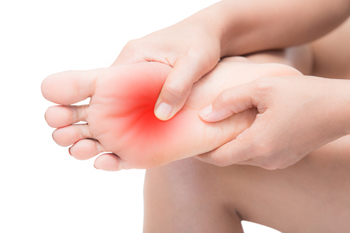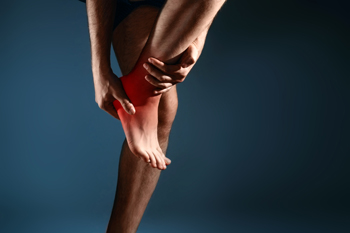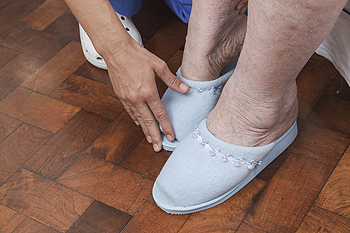Items filtered by date: February 2019
What Is Tarsal Tunnel Syndrome?
 There is a small canal between a bone in the ankle and the ligaments that stretch across the foot that is known as the tarsal tunnel. If this should become compressed and irritated, a condition that is known as tarsal tunnel syndrome may develop. A symptom of this condition may include a tingling sensation in the feet and toes, because this is the nerve that provides sensitivity to those areas of the foot. Additionally, many patients may experience a burning sensation in the sole of the foot. Some of the reasons that this condition can occur may include consistent motion which may come from participating in certain sporting activities. There may be existing medical conditions that may contribute to developing tarsal tunnel syndrome, and these may include flat feet, diabetes, or obesity. If you have any of these symptoms, it is suggested that you seek the counsel of a podiatrist who can properly treat tarsal tunnel syndrome.
There is a small canal between a bone in the ankle and the ligaments that stretch across the foot that is known as the tarsal tunnel. If this should become compressed and irritated, a condition that is known as tarsal tunnel syndrome may develop. A symptom of this condition may include a tingling sensation in the feet and toes, because this is the nerve that provides sensitivity to those areas of the foot. Additionally, many patients may experience a burning sensation in the sole of the foot. Some of the reasons that this condition can occur may include consistent motion which may come from participating in certain sporting activities. There may be existing medical conditions that may contribute to developing tarsal tunnel syndrome, and these may include flat feet, diabetes, or obesity. If you have any of these symptoms, it is suggested that you seek the counsel of a podiatrist who can properly treat tarsal tunnel syndrome.
Tarsal tunnel syndrome can be very uncomfortable to live with. If you are experiencing tarsal tunnel syndrome, contact one of our podiatrists of Carolina Foot & Ankle. Our doctors can provide the care you need to keep you pain-free and on your feet.
Tarsal Tunnel Syndrome
Tarsal tunnel syndrome, which can also be called tibial nerve dysfunction, is an uncommon condition of misfiring peripheral nerves in the foot. The tibial nerve is the peripheral nerve in the leg responsible for sensation and movement of the foot and calf muscles. In tarsal tunnel syndrome, the tibial nerve is damaged, causing problems with movement and feeling in the foot of the affected leg.
Common Cause of Tarsal Tunnel Syndrome
- Involves pressure or an injury, direct pressure on the tibial nerve for an extended period of time, sometimes caused by other body structures close by or near the knee.
- Diseases that damage nerves, including diabetes, may cause tarsal tunnel syndrome.
- At times, tarsal tunnel syndrome can appear without an obvious cause in some cases.
The Effects of Tarsal Tunnel Syndrome
- Different sensations, an afflicted person may experience pain, tingling, burning or other unusual sensations in the foot of the affected leg.
- The foot muscles, toes and ankle become weaker, and curling your toes or flexing your foot can become difficult.
- If condition worsens, infections and ulcers may develop on the foot that is experiencing the syndrome.
A physical exam of the leg can help identify the presence of tarsal tunnel syndrome. Medical tests, such as a nerve biopsy, are also used to diagnose the condition. Patients may receive physical therapy and prescriptive medication. In extreme cases, some may require surgery.
If you have any questions please feel free to contact one of our offices located in Huntersville Office | 16419 Northcross Dr Suite A, Huntersville, NC 28078; Mooresvillle Office | 206 Joe Knox Avenue Suite D, Mooresville, NC 28117; and Mountain Island | 10310 Couloak Drive Suite 200, Charlotte, NC 28216 . We offer the newest diagnostic and treatment technologies for all your foot and ankle needs.
Causes of Ankle Pain
 Research has indicated there are several different forms of ankle pain. Many people will experience some type of ankle pain throughout their lives, and this may come from a variety of reasons. These may include medical conditions such as arthritis, or from an injury. Ankle sprains are considered to be one of the most common forms of ankle pain, and this typically occurs when the ligaments in the ankle and surrounding areas are overstretched. This may happen as a result of tripping or falling, which may cause the ankle to roll inward toward the ground. Other reasons patients may have ankle pain may include infections in the joints of the ankle, nerve damage, or blood vessels that may be blocked. When ankle pain is first noticed, it’s important to rest the foot by taking the weight off of it. If it appears swollen, elevation may bring a mild form of relief. Please consult with a podiatrist who can properly guide you toward feeling better.
Research has indicated there are several different forms of ankle pain. Many people will experience some type of ankle pain throughout their lives, and this may come from a variety of reasons. These may include medical conditions such as arthritis, or from an injury. Ankle sprains are considered to be one of the most common forms of ankle pain, and this typically occurs when the ligaments in the ankle and surrounding areas are overstretched. This may happen as a result of tripping or falling, which may cause the ankle to roll inward toward the ground. Other reasons patients may have ankle pain may include infections in the joints of the ankle, nerve damage, or blood vessels that may be blocked. When ankle pain is first noticed, it’s important to rest the foot by taking the weight off of it. If it appears swollen, elevation may bring a mild form of relief. Please consult with a podiatrist who can properly guide you toward feeling better.
Ankle pain can be caused by a number of problems and may be potentially serious. If you have ankle pain, consult with one of our podiatrists from Carolina Foot & Ankle. Our doctors will assess your condition and provide you with quality foot and ankle treatment.
Ankle pain is any condition that causes pain in the ankle. Due to the fact that the ankle consists of tendons, muscles, bones, and ligaments, ankle pain can come from a number of different conditions.
Causes
The most common causes of ankle pain include:
- Types of arthritis (rheumatoid, osteoarthritis, and gout)
- Ankle sprains
- Broken ankles
- Achilles tendinitis
- Achilles tendon rupture
- Stress fractures
- Bursitis
- Tarsal tunnel syndrome
- Plantar fasciitis
Symptoms
Symptoms of ankle injury vary based upon the condition. Pain may include general pain and discomfort, swelling, aching, redness, bruising, burning or stabbing sensations, and/or loss of sensation.
Diagnosis
Due to the wide variety of potential causes of ankle pain, podiatrists will utilize a number of different methods to properly diagnose ankle pain. This can include asking for personal and family medical histories and of any recent injuries. Further diagnosis may include sensation tests, a physical examination, and potentially x-rays or other imaging tests.
Treatment
Just as the range of causes varies widely, so do treatments. Some more common treatments are rest, ice packs, keeping pressure off the foot, orthotics and braces, medication for inflammation and pain, and surgery.
If you have any questions, please feel free to contact one of our offices located in Huntersville Office | 16419 Northcross Dr Suite A, Huntersville, NC 28078; Mooresvillle Office | 206 Joe Knox Avenue Suite D, Mooresville, NC 28117; and Mountain Island | 10310 Couloak Drive Suite 200, Charlotte, NC 28216 . We offer the newest diagnostic and treatment technologies for all your foot care needs.
Symptoms of Toenail Fungus
 The medical term known as onychomycosis is also referred to as toenail fungus. This condition may cause the toenails to become discolored and brittle, and may gradually separate from the nail bed. The reasons why this condition can develop may include having a medical condition that diminishes blood flow to the feet, or wearing shoes and socks that are too tight. Preventive measures may include wearing comfortable shoes and socks, and making sure pedicure tools are disinfected before being used. Additionally, it may be beneficial to wear appropriate shoes while in public showers and pool areas, and this may limit this contagious fungus from spreading. Many patients find it beneficial to seek the services of a podiatrist who can properly trim the affected nail.
The medical term known as onychomycosis is also referred to as toenail fungus. This condition may cause the toenails to become discolored and brittle, and may gradually separate from the nail bed. The reasons why this condition can develop may include having a medical condition that diminishes blood flow to the feet, or wearing shoes and socks that are too tight. Preventive measures may include wearing comfortable shoes and socks, and making sure pedicure tools are disinfected before being used. Additionally, it may be beneficial to wear appropriate shoes while in public showers and pool areas, and this may limit this contagious fungus from spreading. Many patients find it beneficial to seek the services of a podiatrist who can properly trim the affected nail.
If left untreated, toenail fungus may spread to other toenails, skin, or even fingernails. If you suspect you have toenail fungus it is important to seek treatment right away. For more information about treatment, contact one of our podiatrists of Carolina Foot & Ankle. Our doctors can provide the care you need to keep you pain-free and on your feet.
Symptoms
- Warped or oddly shaped nails
- Yellowish nails
- Loose/separated nail
- Buildup of bits and pieces of nail fragments under the nail
- Brittle, broken, thickened nail
Treatment
If self-care strategies and over-the-counter medications does not help your fungus, your podiatrist may give you a prescription drug instead. Even if you find relief from your toenail fungus symptoms, you may experience a repeat infection in the future.
Prevention
In order to prevent getting toenail fungus in the future, you should always make sure to wash your feet with soap and water. After washing, it is important to dry your feet thoroughly especially in between the toes. When trimming your toenails, be sure to trim straight across instead of in a rounded shape. It is crucial not to cover up discolored nails with nail polish because that will prevent your nail from being able to “breathe”.
In some cases, surgical procedure may be needed to remove the toenail fungus. Consult with your podiatrist about the best treatment options for your case of toenail fungus.
If you have any questions, please feel free to contact one of our offices located in Huntersville Office | 16419 Northcross Dr Suite A, Huntersville, NC 28078; Mooresvillle Office | 206 Joe Knox Avenue Suite D, Mooresville, NC 28117; and Mountain Island | 10310 Couloak Drive Suite 200, Charlotte, NC 28216 . We offer the newest diagnostic and treatment technologies for all your foot care needs.
How to Care for Feet with Arthritis
 Arthritis is inflammation in or around joints and it mainly affects the older population. The inflammation associated with arthritis causes swelling, pain, and stiffness. For some, arthritis can be debilitating, but there are ways to cope with arthritis and reduce the symptoms. Supportive shoes can go a long way for those with arthritis, because arch support can stabilize joints that may be displaced. Stretching helps boost your flexibility and mobility. Stretching the Achilles tendon is a good exercise to help with movement within the joints. Stretching is helpful but should not be overdone if it is causing pain. Foot massages can also help loosen tension in the foot and result in pain relief. Kneading the sole of your foot around the balls of your feet and your toes is an effective method for relief. If you have arthritis and would like to learn about other ways to help care for your feet, it is recommended that you speak with podiatrist for more information.
Arthritis is inflammation in or around joints and it mainly affects the older population. The inflammation associated with arthritis causes swelling, pain, and stiffness. For some, arthritis can be debilitating, but there are ways to cope with arthritis and reduce the symptoms. Supportive shoes can go a long way for those with arthritis, because arch support can stabilize joints that may be displaced. Stretching helps boost your flexibility and mobility. Stretching the Achilles tendon is a good exercise to help with movement within the joints. Stretching is helpful but should not be overdone if it is causing pain. Foot massages can also help loosen tension in the foot and result in pain relief. Kneading the sole of your foot around the balls of your feet and your toes is an effective method for relief. If you have arthritis and would like to learn about other ways to help care for your feet, it is recommended that you speak with podiatrist for more information.
Arthritis can be a difficult condition to live with. If you are seeking treatment, contact one of our podiatrists from Carolina Foot & Ankle. Our doctors can provide the care you need to keep you pain-free and on your feet.
Arthritic Foot Care
Arthritis is a joint disorder that involves the inflammation of different joints in your body, such as those in your feet. Arthritis is often caused by a degenerative joint disease and causes mild to severe pain in all affected areas. In addition to this, swelling and stiffness in the affected joints can also be a common symptom of arthritis.
In many cases, wearing ill-fitting shoes can worsen the effects and pain of arthritis. Wearing shoes that have a lower heel and extra room can help your feet feel more comfortable. In cases of rheumatoid arthritis, the arch in your foot may become problematic. Buying shoes with proper arch support that contour to your feet can help immensely.
Alleviating Arthritic Pain
- Exercises that stretch the foot can prevent further pain and injury and increase mobility
- Most of the pain can be alleviated with anti-inflammatory drugs, heat, and topical medications
- Massages can help temporarily alleviate pain.
It is best to see your doctor for the treatment that is right for your needs and symptoms. Conditions vary, and a podiatrist can help you determine the right method of care for your feet.
If you have any questions, please feel free to contact one of our offices located in Huntersville Office | 16419 Northcross Dr Suite A, Huntersville, NC 28078; Mooresvillle Office | 206 Joe Knox Avenue Suite D, Mooresville, NC 28117; and Mountain Island | 10310 Couloak Drive Suite 200, Charlotte, NC 28216 . We offer the newest diagnostic tools and technology to treat your foot and ankle needs.
